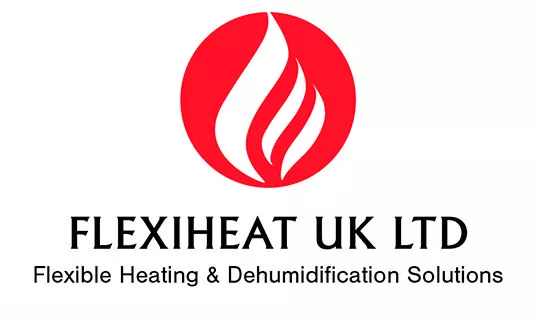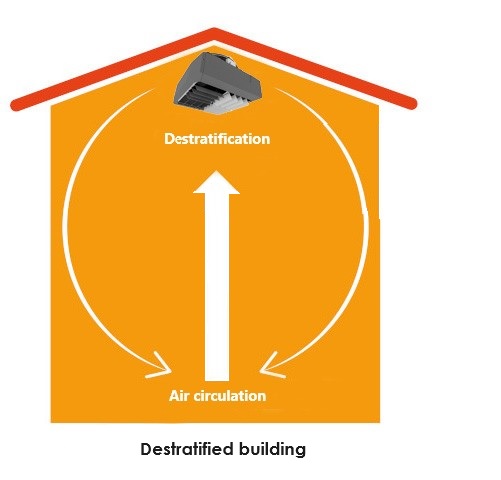Destratification – What is it ?
Destratification – What is it ?
Destratification is the opposite of the natural process of thermal stratification in HVAC systems, which is the layering of different (usually increasing) air temperatures from floor to ceiling. Thermal stratification occurs when heated air rises to the ceiling or roof space or area because it is lighter than the colder air around it. Cooler air, on the other hand, descends to the floor level because it is heavier than the warmer air around it.
Its basic principles of physics really –as this surrounding cooler air falls to the floor level, and the hot air rises, this is the reverse of what we require when heating. We need to send that heat back down to where it is required, to heat the staff or customers of your business, thus reducing energy consumption and lower energy costs and this is where a destratification system solves this problem by using destratification fans.
Destratification technology can also be used on cooled air supplied by air conditioning systems by ensuring that the chilled air is properly mixing, circulated, and distributed equally throughout the building volume.
What is destratification, and how does stratification make it more difficult to keep the temperature constant?
Here we explore the issues of stratified air which is caused by hot air rising up to the roof space or ceiling level.
How does thermal stratification impact our living and working environments, and what is destratification?
This simple yet important law of nature can pose serious challenges to businesses trying to keep their buildings at consistent temperatures for their clients, employees, and inventory. Heating and cooling systems that are not efficient can be expensive and wasteful. Variations in air temperature can have a significant impact on both the working environment of personnel and the shopping experience. Some may be moaning about the heat in one location while others will be too cold, i.e., hot and cold spots.
In temperature-regulated storage facilities where consistent temperatures are necessary, temperature variations can also seriously affect the design of racking systems. This is particularly true in refrigerated storage facilities, where the cold temperatures are necessary to ensure the commodities’ quality and longevity. Many kinds of commodities’ “shelf life” might be impacted by excessively hot or cold storage conditions.
Thermal stratification
The development of “thermal stratification,” or naturally occurring thermodynamic layers, is the cause of the issue. Warm air rises naturally because it is lighter than cold air. To put it another way, cold air is heavier and denser than warm air. The warmer air is forced upward because the heavier object lowers. Thermal stratification is the result, which is a growing gradient of temperatures from the warmest at the top to the coldest at the bottom. It’s possible that many buildings lack high-quality ventilation systems because naturally, hotter layers develop at ceiling level while cooler layers remain at ground level. Thermal stratification can be more problematic in larger, more open spaces.
Open, high ceilings are common in commercial, industrial, and retail facilities, allowing tenants to arrange the space to best fit their needs. Mezzanine floors are prevalent. They are widely used to divide up employee workspaces and identify the various departments inside the company. The significant temperature variations between the various parts of the structure can make this type of space use problematic.
Temperature difference of the air
The “strata,” or ceiling temperature layers, of buildings taller than four metres differ from those at ground level, where standard thermostats are typically installed. Depending on the architecture and design, the temperature differential between the strata may be significant. A building is more prone to experience problems with thermal stratification the higher and more open it is.
Destratification fan systems can be advantageous in this situation. Effective and efficient heating and/or cooling of buildings calls for a tailored solution with a destratification fan or destratification fans ensuring air movement to eliminate air stratification.
Systems for destratification are intended to increase airflow in an area. Strong targeted destratification fans force the warmer air back down from the roof space to the floor area and prevent the temperature stratification by continuously mixing all the air in the building and reducing the temperature difference between the ceiling and floor. Because of this constant airflow recirculation, any extra heat produced by processes, people, or even solar gain ensures all air temperatures are blended equally and reduce the temperature gradient and lower energy costs for your building.
As a result, the temperature stays more consistent throughout. This lowers the energy consumed and thus the energy bills and makes it simpler to keep all your clients and staff at suitable working temperatures.
The benefits of thermal destratification systems
The benefits of thermal destratification systems are clear:
1.A 20% to 40% decrease in heating bills depending on ceiling heights – i.e., the higher the ceiling height, the larger energy savings.
2.Reduced carbon emissions / footprint – the less energy consumption the less carbon dioxide emissions occur
3. More comfortable environment for your customers or staff as you can maintain a even heating temperature within your building.
4.During the summer, destratification fans can also be employed to create cooling draughts of air.
Commercial benefits for business owners
Here are the issues an air temperature difference can present.
Building fabric heat losses will increase without destratification fans
The hotter air in the roof area influences how rapidly the structure loses heat. For example, the working areas temperature may be 20°C. On a chilly day with an outdoor temperature of -2°C, this would result in a temperature differential of 22°C between the working space and the outside. However, the air in the roof space will be roughly 24°C, resulting in a temperature differential of 26°C between the roof space and the outside air.
This is crucial because the temperature gradient influences the rate of heat loss. The greater the temperature differential between the air in the roof space and the outside air, the greater the rate of heat loss through the roof. Reduced heat loss ( and thus saving energy) via the roof covering can be minimised by lowering the temperature of the air in the roof space by using destratification fans to be more energy efficient.
For example, lowering the roof space temperature from 25°C to 21.5°C would result in a 14% reduction in heat loss through the roof surface. In many circumstances, optimising the circulation of warm air by destratification allows for the right temperature in the working space to be maintained using fewer warm air heaters, lowering both capital and operating expenses.
Losses via airflow infiltration
Another consideration is the influence of temperature gradients on the natural rate of ventilation, which occurs when air enters and exits the structure via leakage locations in the building fabric. It is generally known that part of the warm buoyant air ascending into the roof area will escape through high-level leakage spots. This will result in a slight negative pressure, which will attract additional chilly outside air into the structure via lower-level leakage locations. This low-level cold air entering the building lowers the temperature in the building, requiring the heating system to use more energy to achieve the desired temperature. Fabric heat losses and air penetration are especially problematic in older buildings with insufficient thermal insulation and numerous leakage spots.
Conclusion
Destratification fans, by mixing the air, eliminate stratified layers of hot air, successfully achieving temperature equilibrium across the entire space, and reduce energy consumption for heating systems.
Air stratification in buildings can be avoided by allowing the inside air to mix and move about. The temperature will be balanced by homogenising the air, or mixing it up and giving it all the same attributes. We call this process “destratification.”
Should you require more product information or get a project sizing on our destratification fans then please don’t hesitate to contact our sales team on 01202 822221 or use our email contact form via the contact tab above to message us.


